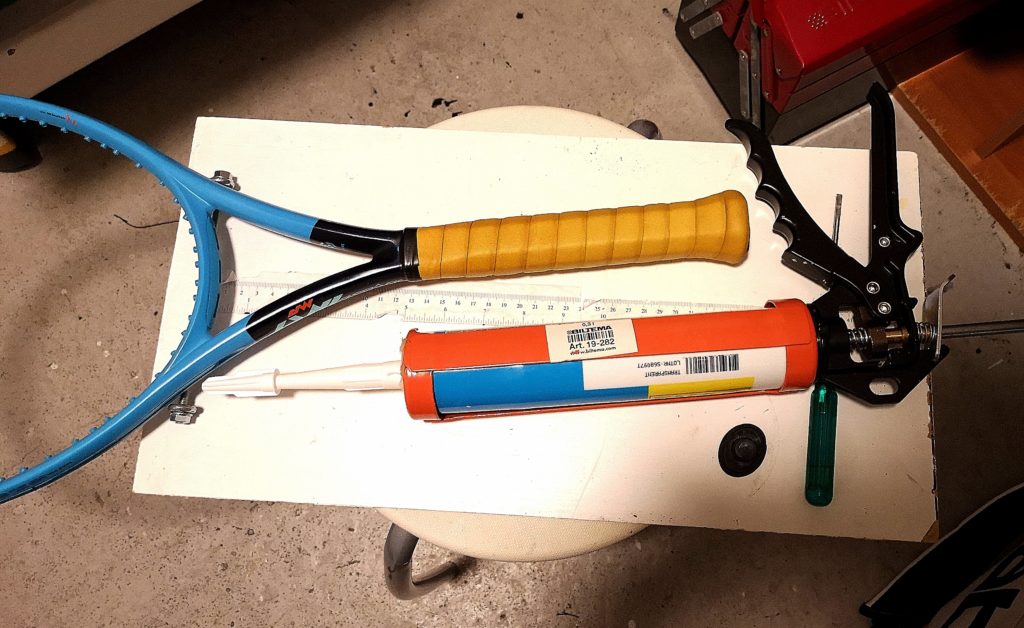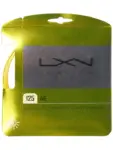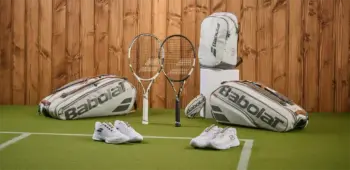The solid feel of a pro-stock frame is almost impossible to get if you just take a frame off the shelf and string it up. This is how to customize a tennis racket.
A pro-stock frame is a frame made specifically for a pro-player, in most cases customized to the exact specs of the unique player it´s intended for. Every player is unique, and everyone has their own required specs that they want to use in their frames. Some players want a very soft frame, some like it stiff (in the flex..), some low overall weight but heavy swing weight and so on.
Do the companies then make frames with all those different specs? NO, they don’t! What they do is to make a so-called hairpin in a very light weight. If you would just add a pallet or mold the handle around the hairpin and install the grommets and a base-grip, the weight would be between 250-270 grams unstrung. Way to light for most players around the world on all levels of play. The hairpin is made in a special mold, that might look very much like the retail version. In some cases it´s actually the very same mold like the retail version of the frame it´s intended to look like, but in a much lighter package and in most cases with a lower stiffness rating in the flex. A stiff frame generates more power and a softer frame more control and feel. Most pros prefer the softer flex.
How to customize a tennis racket – baking the hairpin
When the hairpin is baked in the oven (yes, it´s just like baking a pizza 10-15 minutes in 300 degrees Celsius) and painted in the seasonal paint job, it´s either sent to a pro shop like RPNY, P1, Ring&roll etc for customization, or it´s customized in the so-called ”pro-room” in the brands HQ. Most brands have this pro-room. What they do there is to add lead at various locations, inject silicone into the handle and add a leather grip (in most cases). With these methods, they customize the weight, balance and swing weight (how heavy the frame feels to swing) and this totally changes the feel of the frame.
Good thing though is that it´s pretty easy to do this yourself! Swingweight is a bit tricky so we skip this (important) step but it requires a very expensive so-called RDC (racquet diagnostic center) machine and since I don’t have one I don’t care about it. [You can also use the manual method as suggested by Tennis Warehouse. Swing weight is key if you want to match your racquets (unless they already come matched in SW) so worth investing the time or getting a machine. – Jonas]
When customizing a frame, it´s important not to have a too heavy frame to start with. For example, if you have an old head Youtek Speed Pro with 335 gram unstrung weight, it´s already on the heavy side. If you customize it could be well over 360 grams and it´s only Del Potro that could swing it! Best is to find a so-called ”lite” frame that´s in the 270-290 grams unstrung range. Then you can do the full package with lead, silicone, and leather.
How to customize a tennis racket – Silicone in the handle

What you do first is to install the leather grip (yes, it´s mandatory to use a leather grip as base grip, no questions asked!). When it´s installed, you weight and see the balance. Use a digital scale to see the start weight of the frame with the base grip on. Then use a balance board to see the balance. When you have all the specs, you can use this page to see where to place the weights: http://twu.tennis-warehouse.com/learning_center/customization.php
For example, it can advise you to add 10 grams of lead in the top and 15 grams into the handle. When it comes to the handle it´s easiest to inject silicone with a silicone gun like in the picture. Most butt-caps have a trap-door that you open up and inject the weight you want to add. It will take some trial and error before you get it right, but install small amounts each time and weight it between. Don’t forget to place the trap-door on the scale as it´s about 3 grams.
How to customize a tennis racket – Lead in the head
When silicone is ready, it´s time for the lead. I see some talk about tungsten tape these days, but lead is easier to work with and tungsten also translates to ”heavy rock” on Swedish and it´s not cool on a tennis frame. Lead-tape it is and best is to buy a big roll of lead as it´s really fun to customize frames. Cut the lead tape to right weight and then fold it a couple of times. I often place lead from 10 to 2 on the frames as I like polarized (the weight of the frame polarized to the top and bottom) but you can pretty much place the lead wherever you want on the frame. I always remove the grommets in the top and place the lead-tape, the install the grommets again. There are millions of instructions on YouTube how to remove and install grommets so it´s not exactly rocket science, apart from Babolat grommets. They are a pain in the ass to install! Don’t know why!?
When everything is installed, it´s time to check weight and balance again and don’t forget to take note of the final specs in case you want to duplicate it on a 2nd or 3rd frame. I personally have fallen totally for the retail version of Babolat Pure Strike VS with some magic touch added. I add lead, leather and a small bit of silicone. I also use two overgrips (Wilson pro grip). First layer without overwrap and second layer normal wrapping. Strung at 48 lbs with Babolat RPM Blast 1.25 mm it´s an amazing combination of power, spin and control. Like a Babolat Pure Drive with the feel and control of a legendary Head Pro Tour 630 (well, almost..)
For this article, we used the new Head Graphene 360 Instinct MP. Starting weight was 298 grams with a 32 cm balance. When ready from the customizing it weights around 315 grams and a 31.5 cm balance. This frame is new and un-used and now for sale for 120 euros. I also have one more Graphene 360 instinct MP frame, new and unused. Not customized. Same price, 120 euros. Contact the Tennisnerd for more information.
Thanks, Henrik for the guest post! Do you ever customize your own racquets in this way? Do you have any tips and tricks to share? Let me know in the comments below.






















Adding weight to the head changes the impression of the stiffness of the racquet – heavier racquets seems to be more flexible and “wrap around” the ball a bit more. Also more mass = stability (when applied
on the sides of the head) and power.
Hi how erik customized his racquet and final specs?
Good question! Will ask Henrik to reply.
Hi Henrik,
Great article! Thanks a lot.
Quick questions re. silicon, can you use any type of silicon sold in DIY stores or is there any specific spec to buy? Handle has to be filled completely or you can proceed step by step?
Thanks.
Manuel
Hi Manuel,
Yes, pretty much any silicone. No, you can fill it up partly first and try how that feels and then fill up the rest.
Cheers / Jonas
Instead of silicone people can use bluetack too, because it’s easier to remove or add until you get the right weight.
I do some customization on my lighter racquets, to bring their weight closer to my preferred 345 grams head-light balance spec. Usually I keep my 98’s a bit lighter, in the 330 something range because they are a bit slower to swing.
Thanks for such a useful article! I am a total amateur hack to the customization process but I really enjoy playing with rackets that I’ve personally tweaked. Regarding handle weight, Antonio makes a very good suggestion to use Bluetac first to experiment and play test with different handle weights before committing to silicone. I made the mistake of silcone-ing a couple of rackets before I realized what handle weight I really wanted. I also discovered another hacker’s technique instead of Bluetac for play testing different handle weights before locking it down with silicone. I took a dense memory foam pillow and cut it up into various length and width “rods” that are about twice the width of the handle cavity. Don’t use regular foam–it has to be the DENSE memory foam used for mattresses. Squeeze the memory foam by tightly rolling it your hands and then quickly shove into the handle with a screwdriver before it starts to expand. The foam expands nicely so it won’t move around or dislodge within the handle. Weigh the racket (also measure swingweight if you can), then playtest it. After playtesting, adjust the weight by either shoving another smaller piece of foam into the handle, or removing the original foam and replacing it with a smaller piece. Once I find the right weight, I remove the foam and go for the silicone gun. I have one racket that felt so much better with 20 grams of foam shoved in the handle that I kept the foam and didn’t even replace it with silicone. Totally amateur but it works for me.
Thanks for the tip, Peet. I usually go with Blu-Tack, but foam is a nice idea too and used by many pros on the tour!
One hack I picked up from the TT boards is you don’t need to use silicon in the handle. You can get the same with using Saran Wrap/cling film. Just shove it up the handle, it adds weight, shock absorption, not messy, and most important, you can take it out any time.
Just don’t jam it in too tight. You can straighten a coat hanger and make a hook to get it out if needed. Very helpful if you add too much weight or want to sell the racquet.
Cool tip, Luke!
WOW! You totally canned the Pure Drive VS in your review of that racket. Seems you have found your right spec with it after some customization–perhaps a re-review? Like so many rackets, their playability comes out following some customization. In your reviews, it would be so great to get your new thoughts once you’ve tinkered it to perfection.
I too am really enjoying the PDVS, but with only 4g in the head, 4g in the cap and an overwrap…330g strung.
I would love to hear what your final weight/balance are. I’m guessing it must be at least 350g strung!
Hi Dan,
Hehe, it wasn’t THAT bad. It is definitely not a bad racquet. I was just a bit underwhelmed. My specs were 340 grams and 32,5 cm balance. It did play pretty well that way, LOTS of free power. But personally, I would still have enjoyed a bit more feel from the racquet. Cheers / J
Hehe, I would not say I “canned” it, I had just expected a bit more. With some customizations, it is not a bad racquet! I got it up to around 340+ grams and 32 cm balance – that was a good spec.
Hello, thanks for the interesting article. I am also very curious about the final specs of henrik’s pure strike vs, as I also play with this racket and my specs might be surprisingly close to his (and love it!): 4 grams in the handle, 2 grams on the frame at 12 o’clock and a leather grip, strung with solinco hyper g (gauge 17) at 22kg (48.5 lbbs) for approximate strungs specs of 331g and 32.5 (6pts HL) balance
I will let Henrik reply to this one! :)
Reply to Alex:
I have now sold the PS VS frames and “converted” to Wilson Clash. I absolutely loved the PS VS, but unfortunately my elbow did not approve.
My final unstrung specs was 313.3 grams and balance of 31.3 cm. I had lead on the sides from 8 to 10 and 2 to 4, TW leather grip (1300mm*1,3mm*22mm) and silicone inside the handle.
Jonas.WOW what an in depth racquet tweakers indoctrination, so many many ways to make a racquet perform for a specific player..And now adding overall length to a racquet just got very very easy with a new product I understand that Henrik will soon test for TennisNerd..Its the XTP Xtended Tennis Product butt cap,it a very simple straight ahead product getting the attention of many Do It Yourselfers racquet customizers globally…By simply removing the factory butt cap and installing the XTP tennis butt cap product a player can add easily half an inch or slightly more to any mfg racquet…its been tested already by USRSA United States Racquet Stringers Association and a short write up article was in the June 2019 Tennis Industry Magazine…We think every tennis shop should stock this product and by able now to offer a stretch job with any string job at your local tennis shop…Looking forward to the Review of the XTP tennis butt cap product. Ttuly,john
Nice article. It amazes me how agricultural the process is. I mean adding lead strips and blu-tack is hardly cutting edge technology! This leads me to question how do the manufacturers make different models in the same range? For example, the Pro-Staff 97 is available as 290g, 315g and 340g. Each has the same beam and other dimensions, so does Wilson just add a bit of lead to the PWS bulges, and some in the handle, or are there any actual differences to the overall frame? I heard some frames are foam filled. What sort of weight change does that make? Thanks, beginner customizer here!
hello, tennisnerd I am in desperate need of your adivce!!! how would I customize my racket if I wanted more precision? I am trying to customize the Gravity mp… please help!!!
HI Tennisnerd
May I ask you, how to deal with the bar and nails inside handle of racquet? I’d like to add some BluTac and have an option to remove it later on. In my frame is really lack of space. Is it safe to remove it mechanically?
I prefer removable BluTac before stuff like silicon.
Thank you for your help
Adam
Hi thanks tennis nerd, love your content. What I really want to know is what staple gun do they use in the factory to staple the butt caps to the racket? It must be a pneumatic one that’s for sure but the staples are unique, they are long and thin probably 5cm, normal staple guns have staples that are wider like an inch and aren’t as long which is not as good for the tennis racket handle. Would love to know if you know or anyone else does then I can get one
I have added weight out at 9:00 & 3:00, on different racquets, over the years.
A year ago, after reading an article, I tried putting lead weight in the butt of the handles of my current racquets, to bring the weight up to 300 grams. I was surprised how much this improved the playability of the racquet! it is definitely worth experimenting with different weights in different parts of your racquet.